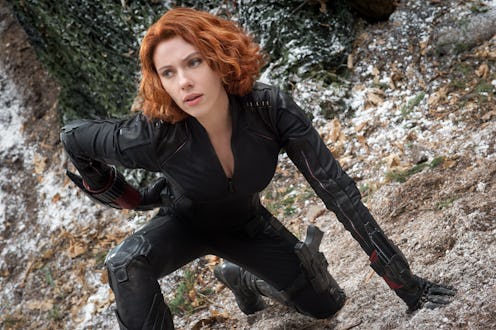Entertainment
Black Widow's Love Story Works In 'Avengers 2'

Nobody would blame you for raising an eyebrow, and a few questions, upon hearing the phrase “love story” assigned to Black Widow’s role in Avengers: Age of Ultron . Hasn’t she got more important things to worry about than blossoming affection for one of her fellow global defenders? Since we still don't have a Black Widow movie, is this really how we want to squander the screen time spent with Natasha Romanoff? And — perhaps most trifling of all — while Tony Stark is wracking his brain over a science experiment gone awry and Thor is bound for a mystical vision quest, isn’t there something just a bit disappointing about the team’s sole female player being wrapped up in a romantic subplot?
But as questionable as the arc might seem on paper, an actual viewing of Avengers: Age of Ultron could well change your mind on what has already been declared a mishandling of Scarlett Johansson’s fan favorite character.
As you’ve likely inferred from the dramatic palm-to-palm scene that shows up in a number of the movie’s trailers, there’s something beyond your basic occupational camaraderie going on between crime-fighting colleagues Natasha and Dr. Bruce Banner. The ground was laid, albeit subtly, in The Avengers, when a state of internal torture was recognized as common between the characters. We didn’t exactly know then what this unifying element would build to, but faith in the plans of bleeding heart Joss Whedon should have at least suggested something passionate yet to come.
In Age of Ultron, the promise of Bromanoff comes to a proper head: Natasha begins her pursuit of a reluctant, nevertheless madly interested, Bruce. Their courtship, as it were, begins early on, tampering in tenderness and bounce as we watch each usually guarded party slowly open up to the other.
Those ready to tear apart the notion of a Black Widow/Hulk 'ship won’t have a tough time. In a vacuum, you might highlight Natasha’s trying fixation on the combative Bruce as the stuff of film noir-era gender politics: A woman driven only by her longing for a man sinks her teeth into the darkest and least amenable one in a five mile radius. In the context of a superhero movie, you’d cling to any of the issues vocalized above: misplaced priorities for, and an abject devaluation of, the only female Avenger. But the secret to why Johansson’s internalized character arc works lies in the form that Marvel’s movies, especially those helmed by Whedon, take — equal parts action-blockbuster and character piece, with either system feeding into the other.
Varied though they may be in form, Black Widow’s contributions to Iron Man 2, The Avengers, and Captain America: Winter Soldier identify all by a thread of self-imposed isolation. The characteristic is fleshed out authentically in Cap 2, wherein earnest-to-a-fault Steve Rogers aches to break the veneer of the glowering Black Widow — it’s that earnestness that keeps Natasha at perpetual arm’s length.
Beckoned in Age of Ultron by an unsolicited glimpse into her past, Natasha is faced with refreshed pains over the very stories from which she has striven to mask herself, and everyone around her. We take a look into the mind of Natasha for the very first time, via Whedon and Johansson’s allowance for a glance at her vulnerability. As the last Avenger we’ve seen broken down, and the one who fought the hardest to fend off such a turn of events, she is, in fact, the most rewarding deconstruction of the bunch. Against all efforts, Natasha is ushered to face the proverbial red ledger that is her personal history. She defines herself as damaged, monstrous, alone.
But what comes from this is not a note of antiquated dependency, as some might be inclined to see it, but a testament to Natasha’s strength and courage in the wake of the biggest struggle we’ve seen her yet endure. She fends back against her worst nightmare to find a way out of it. And the way out of aloneness is…well, that’s a no-brainer.
What most of her fellow Avengers have in common is honesty: Steve’s is innocent, Tony’s is vicious, and Thor’s is more or less without regard. What she recognized in Bruce is someone else who is desperate to hide himself. It’s not painted as logistical as that might make it sound — Natasha finds something in Bruce that she connects to. Someone else tethered to his own island, compassionate for destruction. He’s her kind of people, a rarity among the company she keeps. Why the heck couldn’t she fall for him, and vice versa? In a life as cruel as hers, why shouldn’t she be expected to latch onto the first surefire sign of empathy she’s known in quite some time — perhaps ever?
As for why such a premise warrants space in Avengers: Age of Ultron, that comes down to Whedon’s knack for painting big and small pictures all at once. Every hero’s arc in this movie is rooted in his or her fundamental struggle. Tony, still ridden with PTSD, is desperate to devise a planet without war. Steve, the product of a black-and-white era, is terrified by his loosening grip on the world at present. Hawkeye struggles with the imbalance of his contribution to the Avengers team among that of his colleagues. Black Widow is no exception. Since we met the character, we’ve understood her driving force to be a quest to escape the anchors and pains of her malignant past. In Bruce Banner, she finds for the first time a way that this might be possible. Let’s let her have it, shall we?
Images: Walt Disney Studios Motion Pictures (3)